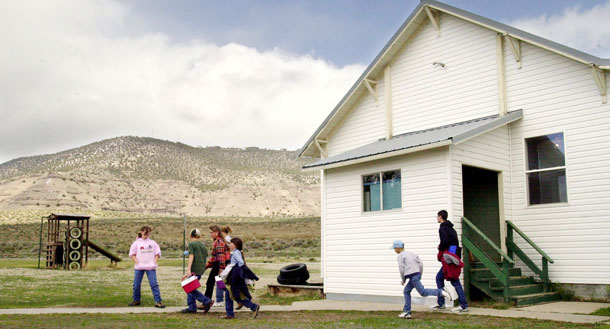
image via americanprogress.org
Several news outlets have reported recently that school districts across the country are turning to a shortened school week to cope with shrinking budgets and to recruit and retain staff. Since the pandemic and the resulting teacher shortage its use has increased rapidly, especially in rural areas. Some states, like Missouri, now have 25% of districts using 4-day school weeks. Many of the articles covering this phenomenon frame their stories as though the 4-day school week is a complete novelty, but it’s been around in mostly rural locations since the 1930s. And this is fortunate, because it means there is some research out there that can help us examine what effect a shorter week has on students across a range of metrics. So let’s look at the pros and cons of the 4-day school week, item by item.
Cost Savings: Pro?
Cost savings are generally fairly small with the move to a 4-day week and are dependent on whether buildings are open on that 5th day or not. On average, districts see around 2.5% cost savings but savings range from 0.4% to a maximum of 5.43%. This may seem insignificant, but 2.5% of a million-dollar budget is $25,000 — enough to fund a program or even bring in a reading specialist part time. Actual savings, though, will vary considerably by district with many only seeing minimal financial benefit. So we’ll call this one a ‘pro,’ but qualify it with a big maybe.
Improved Teacher Recruitment and Retention: Undetermined
Although the 4-day school week is marketed as a perk for new and current teachers, there’s only anecdotal evidence that it is effective as a tool for recruitment and retention. A study of 12 rural school districts found that Teachers reported feeling less burned out and missing fewer instructional days due to illness or exhaustion, but that’s a relatively small sample and self reported — no data from the districts confirmed that teachers missed fewer days. A quick survey of available research indicates that a lot of people like the 4-day schedule, but there’s almost no data quantifying how well it works to attract and keep teachers. I was able to find one study that offered a glimpse into its effectiveness as a long-term recruitment tool. The study found that after 2 years of a 4-day school week, retention was 3% lower for teachers overall and 5% lower for veteran teachers of 15 years or more in schools with 4-day weeks compared to similar schools with traditional schedules. Since the 4-day week often compensates for a lower salary, researchers concluded that teachers who left the district were unwilling to trade off the higher salaries offered by other districts for the benefits offered by a 4-day week.* Although more data would be nice, I think the point is moot for reasons that will become clear shortly.
 School Climate: Pro
School Climate: Pro
A study from the Center for School and Student Progress at NWEA analyzed nine years of data from attendance and behavior incident reports, a dozen years of demographic data, and ACT results for public high school students attending 417 districts in Oklahoma between 2007-08 and 2018-19 as those districts transitioned from 5-day to 4-day weeks. After the transition, bullying incidents decreased 39 percent, or .65 fewer incidents reported per 100 students, compared to bullying rates before the schedule change. Fighting and assaults dropped by 31% to .79 incidents per 100 students. The study showed that while the initial drop in fights and bullying was likely mechanical — less time in school means less opportunity for bullying — the percentages are continuing to drop so there may be something inherent in the schedule that mitigates against these types of interactions. Additionally, an overwhelming proportion of parents and students (95%) approved of the schedule change, which one of the researchers thought might indicate improved morale, though I think that’s reading into the data. Approval of a schedule isn’t the same as higher morale at school and in fact might be correlated to lower morale (as in, ‘I approve of the shorter schedule because it stinks so much to be at school’). However, on balance, the 4-day school week does seem to improve school climate overall.
More Student Sleep: Neutral
A 2021 study by the Robert Wood Johnson Foundation found that 4-day/week elementary kids got more sleep during the school week than 5-day/week kids, but middle and high school sleep remained the same. Call this one a draw.
Attendance: Neutral
The net impact on attendance was neutral — the shorter week had no effect on attendance rates in studies. Focus group evidence indicated that in rural locations, where doctors’ offices, retail centers, orthodontists, and so forth can be several hours’ drive away, the 4-day week gave families the opportunity to handle those duties without missing a day of school. However, if those things were detracting from instructional time, attendance rates should have been positively impacted by the shorter week. Anecdotally, some Native American school officials indicated that the long weekends allowed students to attend cultural celebrations without having to sacrifice school.
Student Proficiency: Neutral
That same RWJF study indicated that there was no significant difference between four- and five-day districts when looking at absolute measures of student proficiency. That would seem to indicate that the 4-day week doesn’t help or harm student learning, but several other studies looked at more than just absolute proficiency. Read on….
Student Academic Growth: Con
Here we go. There are multiple studies at play here but the findings in a nutshell are that 4-day school weeks have a negative impact on academic achievement over time. To study the effects of the 4-day week, researchers looked at a variety of outcomes in six states—Colorado, Idaho, Missouri, New Mexico, Oklahoma, and South Dakota. They compared achievement in English and math in grades 3 through 8 in schools that adopted the 4-day school week against the achievement of their 5-day-a-week peers. They found that students in districts with 4-day weeks fell behind their 5-day week peers a little every year and that the deficits accumulated over time. Researchers estimate that after eight years, the damage to student achievement will equal that caused by the pandemic. Another 2021 study in Oregon calculated that the four-day week shaved off one-sixth of the usual gains that a 5th grader makes in math, equal to about 5-6 weeks of school.** Even when districts increased the length of the school day by 50 minutes they still averaged 58 fewer hours of instruction over the course of the school year.
A 2023 study from Brown University’s Annenberg Institute found that the deficits varied by gender and ethnicity. The 4-day week had a greater negative effect on female students’ math and reading gains than male students and a greater negative effect on Hispanic students’ math gains relative to White students. Uniquely, the 2023 Annenberg study also found that reading achievement was affected more than math — the reverse of what happened during the pandemic — and that all negative effects were much worse for suburban and small-town schools implementing 4-day weeks. In fact, when researchers removed suburban and small-town schools from the data and only compared rural students who attended 4-day schools with rural students who attended traditional 5-day schools, they found little difference. This may indicate that the 4-day week is only a viable policy in rural areas.***
There’s a lot about the 4-day school week that is dubious at best. It may or may not result in meaningful savings to districts. As a means of addressing teacher recruiting and retention, it’s unlikely to outweigh better pay in the long run. But to me, the kicker is the damage it does to student achievement. On that basis alone, the 4-day school week should only be implemented with extreme caution and with a commitment to monitoring its effects on learning for all student groups.
*This article from Rand.org provides an interesting, logical explanation of how the 4-day school week can lose its effectiveness as a recruitment strategy. Especially interesting was the data showing that the number one predictor of whether a district will transition to a 4-day week is whether a neighboring district already has a 4-day week. They helpfully point out that if all the districts in a geographical area use a 4-day school week, it ceases to be a perk. This is especially true if the districts in question are using the 4-day week to compensate for lower salaries. The result is only a short-term gain in staffing.
**Interestingly, school principals, teachers, parents, and students reported believing that students learned just as much or slightly more in the 4dsw than in a 5dsw, and that the difference in minutes of instructional time had no real effect on student achievement. In this case, perception is completely out of sync with performance.
***A fascinating possible explanation for this phenomenon is the prevalence of sports in rural areas. Because of the travel requirements, many rural athletes miss school on Fridays for games and there may be so few students remaining in class that teachers decline to teach. Researchers posit that since many (if not most) students are only getting 4 days of instruction a week anyway, the 4-day school week doesn’t have much effect on their achievement.
